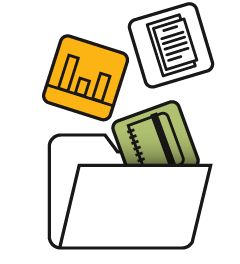
Better Personas, Better Marketing: Start With This Practical Framework
Understanding who your ideal clients or buyers are—what drives them, what challenges they face, and how to genuinely connect with them—is key to leveling up your marketing. But to do that effectively, you’ll need to move beyond surface-level “avatar” exercises and build data-informed audience personas that help you deliver more personalized, impactful content across multiple audience segments.
For example, a local nonprofit might focus on a donor persona as its main “buyer,” but its message also needs to resonate with supporting audiences like volunteers, local press, or community leaders, each playing a role in shaping donor behavior.
Similarly, a marketing director at a mid-size SaaS company may be researching a new CMS, but her CFO and CEO will heavily influence her decision. If your message only speaks to her—and not to the broader circle helping her decide—you risk losing the deal to someone who did.
Let’s explore how you can create personas that resonate with your core buyer and the broader ecosystem that influences them.
If you want to follow along with our template, we’ve created one for you to use with Canva or Google Docs.
Approaching Audience Personas and Buyer Personas
Exploring audience personas and traditional buyer personas is a strategic way to broaden your marketing effectiveness and achieve greater efficiency. Here’s how this approach can be beneficial, followed by a clear breakdown:
Audience Personas (Broader approach):
- Focuses on the broader characteristics and behaviors of groups within your overall target audience.
- Captures shared traits, pain points, aspirations, behaviors, and decision-making influences without overly narrowing to a single idealized customer.
- Recognizes both direct buyers and indirect influencers within their ecosystem.
Buyer Persona (Traditional approach):
- Highly detailed fictional representation of an ideal buyer of your product or service.
- Includes specific personal attributes, professional backgrounds, demographic details, pain points, goals, and decision-making criteria.
- Often narrowly focused, potentially limiting the reach and flexibility of marketing campaigns.
We need both buyer and audience personas in our marketing ecosystem.
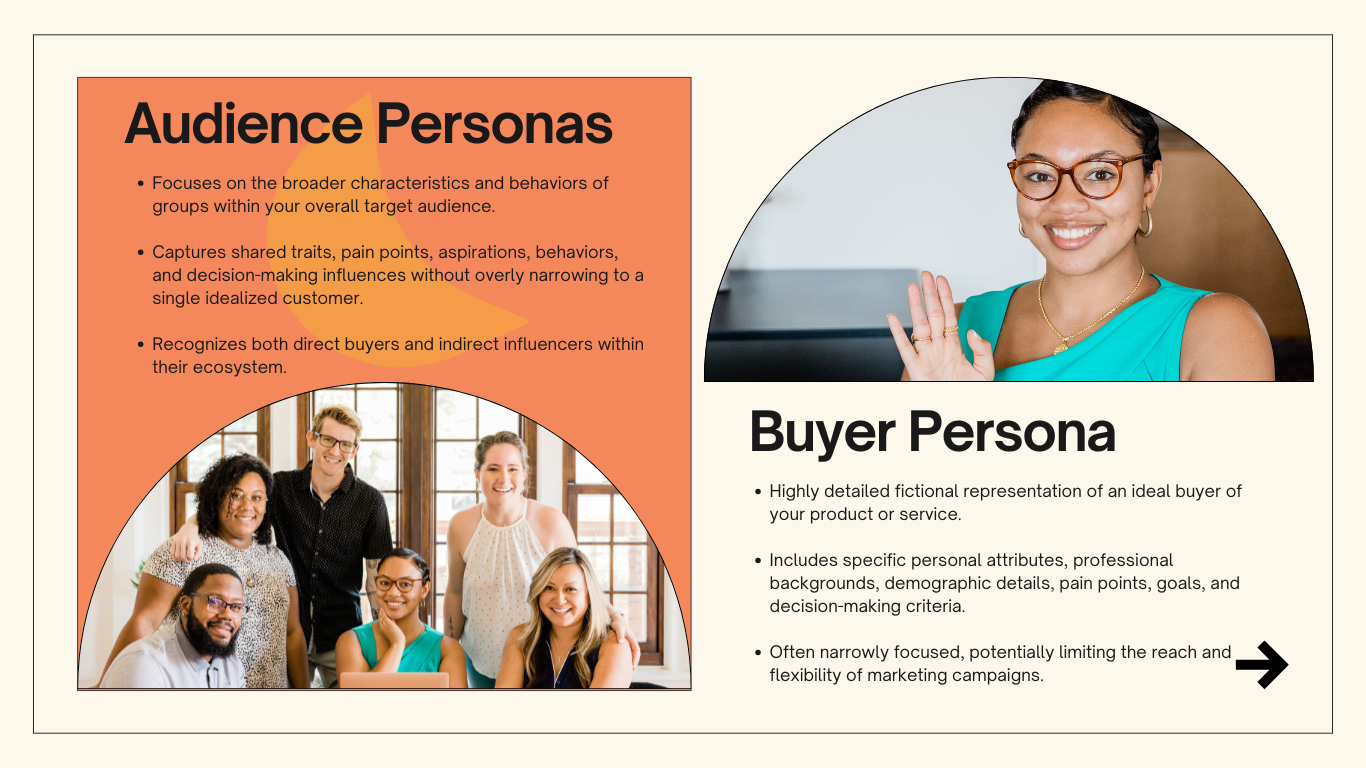
Why Create Audience Personas
- Broader Market Reach
Audience personas help you reach broader segments by aligning your messaging with multiple related groups. For example, creating personas for volunteers and donors at your nonprofit can uncover shared values you can highlight in your marketing to effectively engage both audiences. - Cost-Effectiveness
Addressing shared traits and needs can help you develop campaigns with wider applicability, lower production costs, and optimize your marketing budget. - Influencing Decision-Makers and Influencers
Your audience typically includes both primary decision-makers/buyers and influencers. Audience personas strategically cater to both, increasing your overall campaign impact. - Flexibility
With less rigid definitions, your marketing team can pivot or adapt messaging quickly as market dynamics or audience behaviors evolve.
How To Create Audience Personas
Practical Framework: IRDDMR for Developing Audience Personas
Use this structured, step-by-step framework to create effective audience personas for your marketing campaigns.
I – Identify
Clearly outline your broad target audience segments.
- Define groups by industry, roles, interests, or pain points.
- Segment into decision-makers and influencers.
R – Research
Gather insights to deepen your understanding of these segments.
- Conduct surveys, interviews, or analyze industry reports.
- Explore online behavior, communities, and content preferences.
D – Develop
Create your buyer and audience personas based on research findings.
- Document common traits, motivations, challenges, and preferences.
- Clearly articulate messaging angles tailored for each persona.
D – Distribute
Deploy your messaging across relevant channels and platforms.
- Target platforms frequented by your defined segments (e.g., LinkedIn, podcasts, industry blogs, newspapers, promotional products).
- Use multiple formats: local ads, videos, direct mail, or social posts.
M – Measure
Evaluate performance to assess persona effectiveness.
- Track engagement metrics (clicks, shares, comments, conversions).
- Compare segment responses to refine targeting insights.
R – Refine
Continuously adjust and optimize your personas.
- Update personas based on new data and insights.
- Refine messaging, channels, or targeting strategies to enhance results.
How to Create Your Personas
Step 1: Identify
These first three steps go hand-in-hand. Think of this phase as building a well-rounded sketch of your buyer persona and broader audience personas. The goal is to understand who you’re talking to—and what matters to them—before crafting any messaging.
Target Audience Definition
A target audience consists of groups likely to be interested in your product or service, either directly as buyers or indirectly as influencers of buying decisions. This group shares common characteristics such as:
- Professional Traits: Job roles, industries, seniority levels.
- Behavioral Traits: Common pain points, motivations, information sources, and decision-making styles.
- Relationship Dynamics: How influencers and decision-makers interact within the buying ecosystem.
Using a For-Profit B2B Example:
- Industry: Financial Services
- Target Audience:
- Decision-makers: CFOs, finance directors, business owners.
- Influencers: Accountants, financial analysts, department managers.
- Common Traits:
- Concerned about cost efficiency, operational risk, compliance, and ROI.
- Influenced by peer recommendations, professional networks, online reviews, industry reports, or trusted publications.
Start With What You Know
You probably already have some useful data at your fingertips. Look through:
- Website analytics
- Social media insights
- Customer records
- Email open/click rates
From there, look for patterns. What roles do your buyers hold? What challenges do they face? What platforms are they most active on?
If you lack data, don’t worry—run a short survey or reach out to a few past buyers. Even a handful of conversations can reveal common threads.
What to Look For
Here’s a quick list of traits to gather:
- Job title or professional role
- Income or company size (especially for B2B)
- Challenges they face that your product/service can solve
- Who they follow online (influencers, thought leaders, etc.)
- Interests tied to your brand or industry
Once you have the basics, go deeper. Are they working at a fast-paced startup or a well-established enterprise? Those details shape how you speak to them.
Where Are They Hanging Out?
This part is all about discovery. Where does your audience go to learn, grow, and connect? Start making a list of:
- Relevant publications or blogs
- Industry forums or online communities
- Influencers or creators they admire
- Platforms they use for work or inspiration
You’ll start to see where your messages need to show up—and in what tone.
Step 2: Research:
Talk to Real People
The best insights often come from real conversations. Reach out to current or past customers. Ask open-ended questions like:
- What’s the hardest part of your day?
- What problem, if you could solve it, would let you sleep better at night?
- How did you find us?
- What do you wish was easier when it comes to [your product/service]?
If you’re in B2B, dig into workplace frustrations or decision-making processes. If you’re in ecommerce, ask about product discovery and shopping habits (especially on platforms like Instagram or TikTok).
Do Some Market Recon
You can also broaden your view with external research. Great sources include:
- Google search trends
- Online reports and surveys
- Google Analytics
- Industry blogs or publications
- Financial or educational databases
These can help you validate your assumptions or uncover new insights.
Spy on Your Competitors
Now it’s time to play detective. Find out your organic competitors—those who rank near you on Google—and check out what they’re doing.
Use tools like SimilarWeb to see their traffic and audience profiles. Browse their social feeds to see:
- Who they follow
- Who’s engaging with them
- What content is landing well
You might discover influencers, content formats, or messaging strategies worth adapting. Let their trial and error work in your favor.
Step 3: Develop
You can create a long-form version in a document linked from your presentation, which can be high-level points. For example:
Create Your Documents
Meet Taylor, Marketing Director
Name: Taylor S.
Age: 38
Job Title: Marketing Director
Location: Seattle, WA
A Day In the Life:
Taylor works at a mid-sized B2B SaaS company that serves enterprise clients. She’s been in marketing for over a decade and is known for her creative mindset, ability to juggle multiple projects, and her knack for turning strategy into action.
A Day in Taylor’s Life:
Taylor starts her day reviewing campaign performance metrics with her team over coffee. She spends her mornings in strategy meetings or collaborating with product and sales leads to align messaging and positioning. Her afternoons are often packed with reviewing content, approving creative assets, mentoring junior marketers, and troubleshooting gaps in campaign performance. She ends her day checking in with external partners and vendors—often from her phone during her daughter’s soccer practice.
“I wish I had more time to focus on strategy instead of constantly putting out fires.” — Taylor
Work-Related Goals
Launch consistent, high-performing campaigns Increase brand visibility and customer engagement Build a high-functioning, collaborative marketing team Drive measurable ROI from every tool and tactic
Work-Related Challenges
- Too many disconnected marketing tools
- Not enough internal support for content production
- No strategic day-to-day partner
- Unclear performance tracking and reporting from vendors
- Managing up while also managing down
Work-Related Needs
- Simplified tech stack with clearer data visibility
- Vendors and partners who take initiative and deliver insights
- Time-saving automation tools that integrate with existing systems
- Access to expert-level advice for campaign strategy and growth
Personal Characteristics
- Strategic thinker
- Strong communicator
- Collaborative, but protective of her time
- Often balancing work and parenting
Hobbies + Interests
- Yoga and hiking on weekends
- Listening to marketing and leadership podcasts
- Hosting wine-and-dine nights with close friends
- Following design trends and creative advertising campaigns
Where Taylor Gets Her Information
- LinkedIn thought leaders (especially in B2B SaaS)
- Podcasts like Marketing Over Coffee and Demand Gen Visionaries
- Industry blogs like HubSpot, Content Marketing Institute, and Gartner
- Slack communities and peer groups for marketing leaders
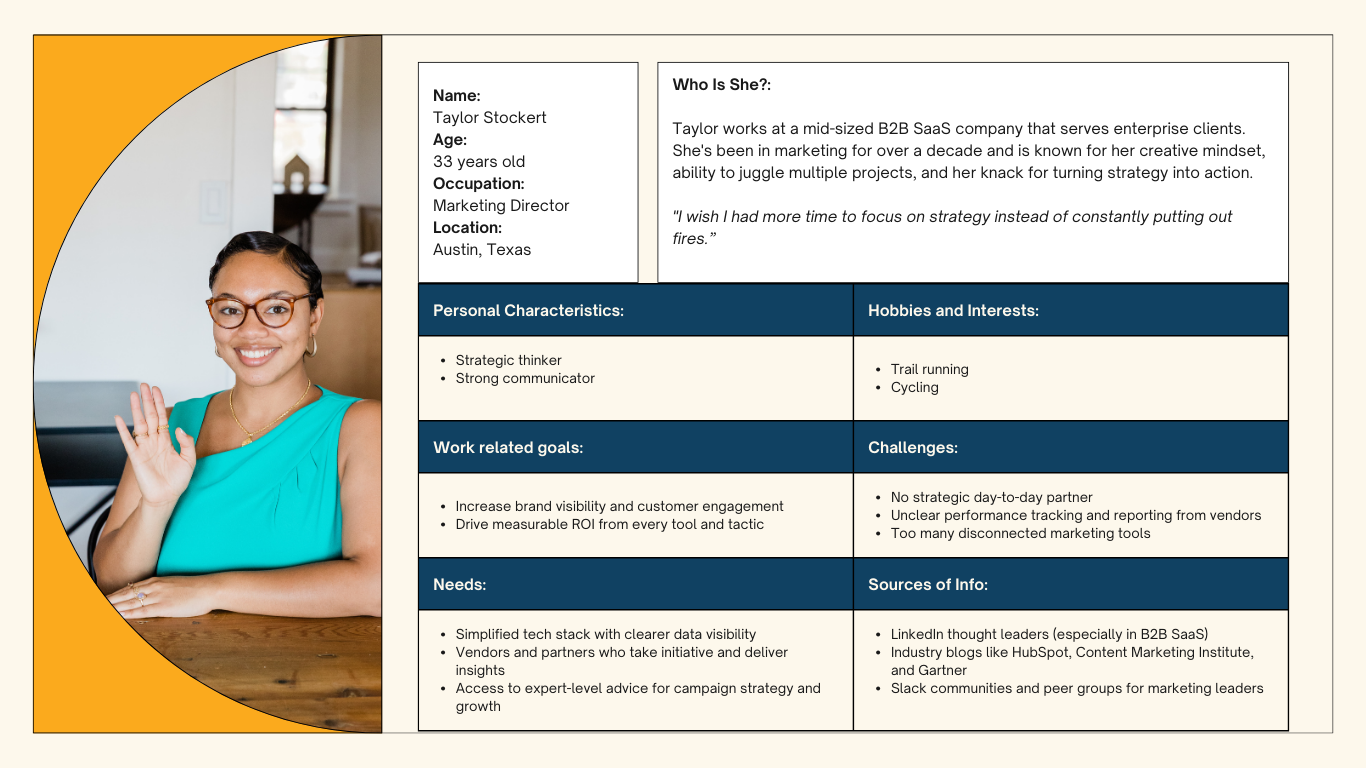
Step 4: Distribute
Once you’ve developed your personas, the next step is ensuring your message reaches them. For a B2B marketer, use platforms and channels where your buyers and their influencers are already spending time. This could be LinkedIn, industry blogs, newsletters, niche podcasts, Slack communities, or industry events.
A geographic-specific nonprofit looking to reach more volunteers might reach them at a Saturday market, a local newspaper ad, or a Google ad.
Consider not just where they consume content but also where they actively engage, ask questions, or share recommendations.
Distribution Strategy in Action
The chart below illustrates the targeted distribution strategy we created for one of our nonprofit clients. Each distribution channel was mapped to a specific stage of the buyer’s journey—from creating awareness to driving retention.
We identified the platforms where key audience segments (donors, volunteers, local press, and community partners) already engage. Then, we aligned content across each platform based on how it supports a user’s progression through the journey:
- Awareness: Social channels like Facebook, Instagram, LinkedIn, and Google Ads Grant help capture attention and introduce new audiences to the organization.
- Consideration & Engagement: Their website and ongoing content marketing/events provide more in-depth value, encouraging users to learn more and engage with the mission.
- Conversion & Retention: Channels like email marketing, local press, community groups, and networking events are designed to nurture relationships and support long-term involvement, advocacy, or giving.
This structured approach ensures that each piece of content meets the audience where they are while guiding them forward. As part of a comprehensive digital marketing strategy, we develop your audience personas and identify the right distribution channels for every stage of your customers’ journey.
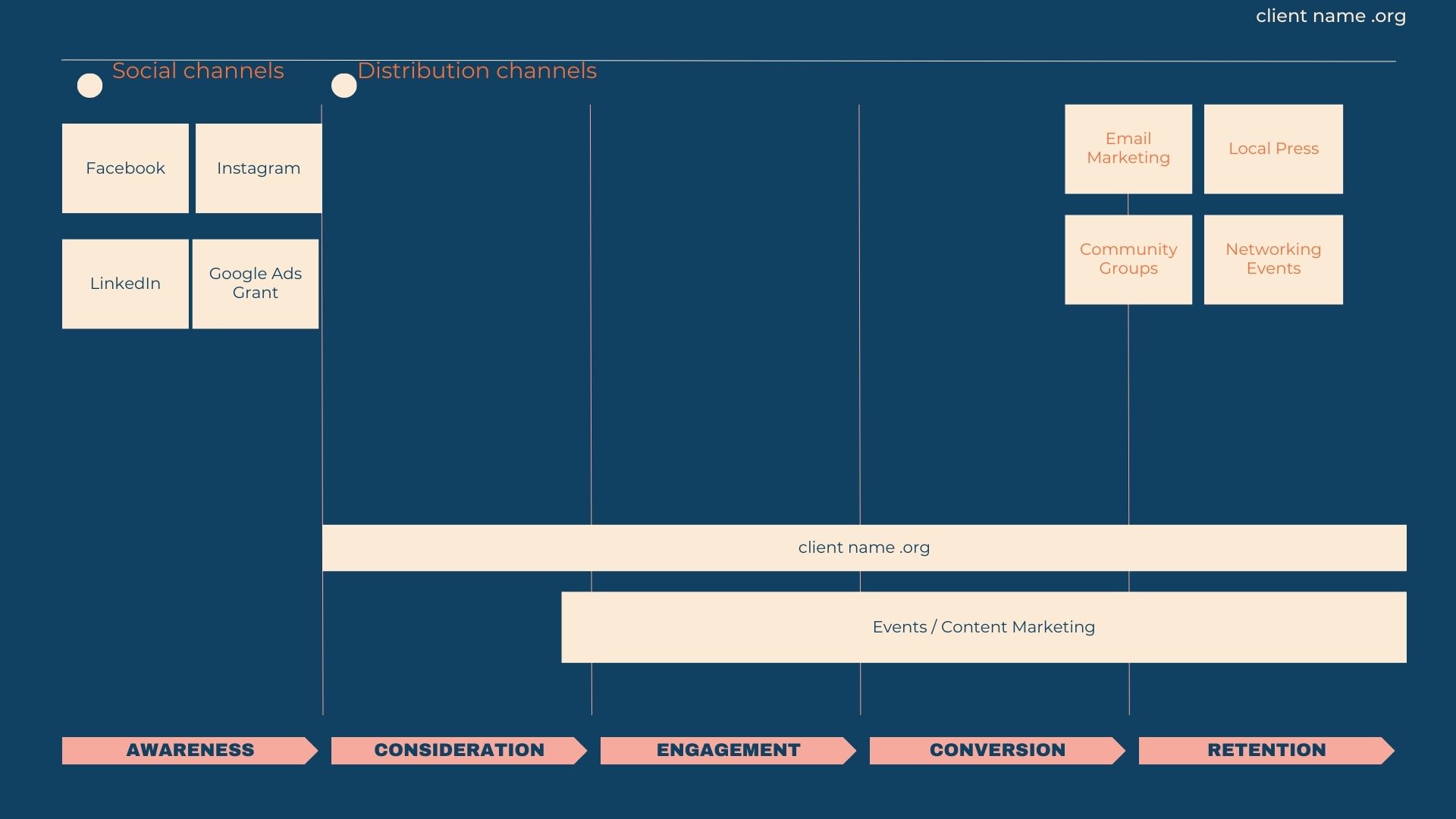
Step 5: Measure
If you didn’t already have an Analytics platform set up to track your marketing metrics, now is the time to get that up and running.
Measurement helps you understand what’s resonating—and where you need to pivot.
- Track performance across key metrics: clicks, conversions, engagement, time on page, and more.
- Break down results by audience segment to see which personas are responding and which need refinement.
- Pay attention to patterns in behavior and engagement to assess persona alignment with content and channels.
Consistent measurement ensures your audience personas stay aligned with real-world behavior, not just assumptions.
Depending on your CMS type, you may have built-in analytics dashboards that will help you monitor your progress, as is available on Wix or Squarespace. Or, if you are on WordPress, you may need a custom solution like the one we provide our clients, using Google Analytics/ Google Tag Manager and Looker Studio.
At the start of this framework, we identified and developed your audience personas. If you are working with us on your overall digital marketing strategy, we will have established a content strategy with clear benchmarks to measure progress over time.
We set realistic goals based on where you are now—looking at traffic, leads, and conversions—so we can measure growth year-over-year.
Here’s what we’ll track along the way in a Looker Studio Dashboard that is customized with your metrics, and you’ll be able to access 24/7 to see where you are with meeting your goals:
- Traffic from SEO and AI-driven search engines
- Engagements such as content downloads, form submissions, and email subscriber growth
- Conversions at the bottom of the funnel, including:
- Sales
- ROI
- Retention and repeat engagement metrics
These data points help us understand what’s working, what needs adjustment, and how to continuously improve results.
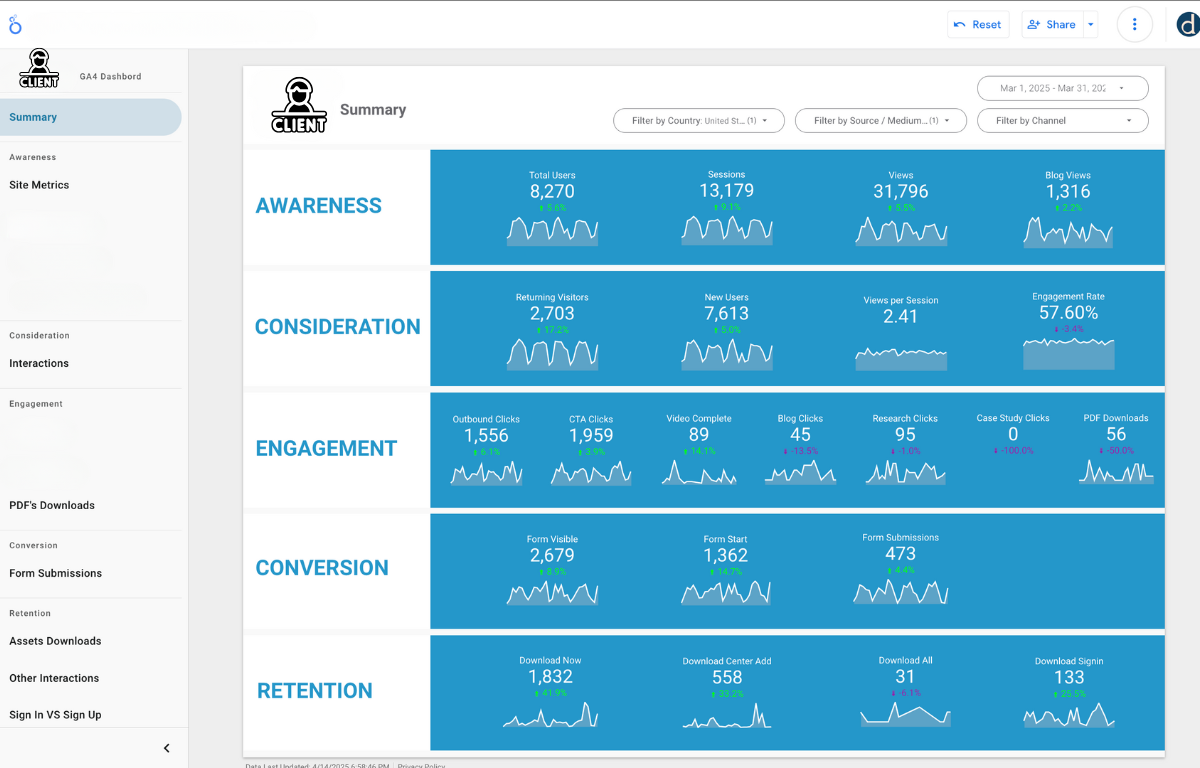
Step 6 – Refine
Audience personas aren’t a one-and-done task. As your audience evolves, so should your personas and strategy.
- Regularly update your personas based on fresh data, feedback, or market shifts.
- Refine your messaging, creative formats, or distribution channels to better meet your audience’s needs.
- Use insights from testing and performance metrics to iterate and optimize your approach.
Keep your personas in an editable format on a shared drive so all stakeholders can be involved in evolving the documentation.
The best personas are living, evolving tools—refined over time to stay relevant and results-driven.
Final Thoughts…
Unlike traditional buyer personas that focus narrowly on the end decision-maker, audience personas provide a broader and more effective view of your entire ecosystem. They allow you to craft content that resonates with your core buyer and the influencers, advocates, and communities that shape their decisions. This broader approach creates more opportunities for Keyword intent optimizations, connection, trust, and long-term engagement, without increasing your marketing spend.
Our IRDDMR framework helps you bring those audience personas to life:
- Identify your key audience groups and segments
- Research their motivations, challenges, and behaviors
- Develop tailored personas with relevant messaging
- Distribute across the right channels where both buyers and influencers engage
- Measure performance against goals and engagement benchmarks
- Refine your personas and strategy with real-world insights
With this framework, you’re not just guessing—you’re creating a scalable, strategic approach that meets your audiences where they are and moves them closer to action.
Need some assistance? Have questions about how to create these documents?
We’ve included a free Persona template for you to use with Canva or Google Docs.
Once you subscribe, the persona template will be emailed to you as a link to a Google Slides presentation. You can make a copy, download, and use it in any design program that supports presentations. If you need another format, just hit reply and I’ll email it to you.
You’re now on your way to better personas, better marketing!


